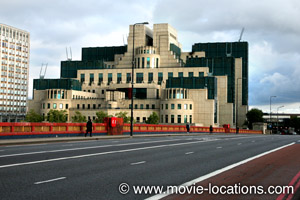

The explosion lasts for over 7.5 seconds, took thirty-three kilograms (seventy-three pounds) of powder explosives, and 8,418 liters (2,224 gallons) of kerosene to explode, which is an equivalent of sixty-eight metric tons (seventy-five tons) of TNT. The award was presented to the movie's special effects and miniature effects supervisor, Chris Corbould.
#Building in spectre film movie
The massive explosion seen towards the end of this movie has been awarded a Guinness World Record as the largest movie stunt explosion of all time. We spent a lot of time testing the cars, making sure they could cope with the punishing regiment that the guys put them through."
#Building in spectre film drivers
We didn't want the drivers to get injured, and also we didn't want them damaging buildings that are thousands of years old. Vehicle supervisor Chris Corbould stated that the Rome car chase allowed no room for error: "The stunt drivers were driving around Rome at one hundred miles (one hundred sixty kilometers) per hour, so absolutely everything had to be perfect as far as their performance was concerned. Though the audience only ever sees two cars on-screen, the second unit used a total of eight Aston Martins, and seven Jaguars to shoot the chase. There was a lot of toing and froing in Rome." In the end, the production was able to shut down key portions of the city, including a section alongside the Tiber, looking towards St.

It was a constant process to find the right location to fit the stunts. A lot of the time when we asked for permission, we would get a yes, but some of the time we'd get a no, so we would have to try and find other roads. The logistics of filming the car chase in Rome, Italy were difficult to marshal, according to stunt coordinator Gary Powell, who said: "In Rome, we saw a load of roads we liked, and sometimes the road is specific to a stunt, because it had a feature which would be really nice to jump. Pill laughed, adding: "That's a lot of radios to hand out and coordinate on a night, but it ran extremely smooth each time." We also worked very closely with the House of Commons, County Hall, and The London Eye to keep various lights on or off, or to change the color of their lights for each night shoot." Each night shoot involved a location team of nearly 200 personnel that included Marshals, security, traffic management, and police officers. We also lit the river from ten rooftops along the bank of the Thames, from Vauxhall Bridge to Hungerford Bridge, working with Lambeth Palace, Tate Britain, and the Royal Parks to gain permission. These lights then remained in position for five weeks. We lit under each arch of Vauxhall, Lambeth, and Westminster Bridge, seventeen arches in total. This involved several weeks of preparation. Supervising locations manager Emma Pill said: "The biggest challenge, however, was to light the river at night. In order to complete the London scenes involving low-flying helicopters, the production had to send out 11,000 letters to residents and businesses that fell within the fly zone.


 0 kommentar(er)
0 kommentar(er)
